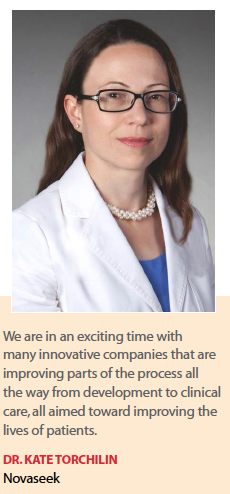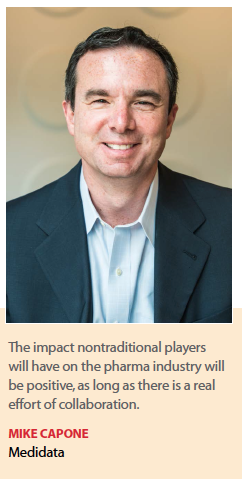Nontraditional players have recognized the tremendous opportunity that lies in the healthcare space, and are innovating with or without pharma partners to solve many of the healthcare issues that patients are dealing with. Companies such as Apple, Google,  General Electric, Samsung, Microsoft, and IBM are flooding the healthcare market with innovative approaches to medicine. Nontraditional players are developing diagnostic and decision-support tools; providing easy access to healthcare records; inventing self-monitoring tools for patients; and facilitating access to, and analysis of, big data. These newer entrants are more naturally inclined to bring a more patient-centric focus to their solutions and to embrace technology as the way to solve these problems.
General Electric, Samsung, Microsoft, and IBM are flooding the healthcare market with innovative approaches to medicine. Nontraditional players are developing diagnostic and decision-support tools; providing easy access to healthcare records; inventing self-monitoring tools for patients; and facilitating access to, and analysis of, big data. These newer entrants are more naturally inclined to bring a more patient-centric focus to their solutions and to embrace technology as the way to solve these problems.
“Players such as General Electric, IBM, Google, and Microsoft are revolutionizing pharma’s understanding of population health issues, helping to conduct clinical trials and decipher the data, and performing clinical research to develop groundbreaking new therapies," says Robert Palmer, executive VP, managing director, JUICE Pharma Worldwide. “This phenomenon can only benefit pharma as these nontraditional sources of innovation develop new approaches to a wide variety of issues and needs."
Healthcare represents a significant market opportunity worth trillions of dollars, and PwC analysts report that companies outside of the industry recognize that their global reach, customer insights, and established reputation are differentiators that can help grab  market share. In addition, trends such as changing demographics, globalization, technological advances, and the growing power of the consumer are all impacting the delivery and financing of care.
market share. In addition, trends such as changing demographics, globalization, technological advances, and the growing power of the consumer are all impacting the delivery and financing of care.
Nontraditional companies have the luxury of being able to move more quickly and, due to their business practices, are better at sensing and serving emerging and hidden needs.
From data, insurance, service design, behavior modification, and patient experience, all the way to genomics, emerging entities in healthcare are uncovering a need for a simplification and solving for it, says Richard Schwartz, senior VP, marketing and connected health partnerships, Publicis Health.
“There are no fewer than 7,000 start-up companies currently focused on health innovation globally, making this one of the largest investment sectors for VCs," he says. “Startup Health pins the 2016 venture capital backing in health innovations at $8.1 billion."
Traditionally, healthcare has moved slowly compared with other industries, in large part due to the time necessary for the clinical development and regulatory processes.
“Nontraditional players are arising due to technological advances that are enabling tremendous innovation and will have the effect of creating a more nimble industry," says Kate Torchilin, Ph.D., CEO of Novaseek Research.
“We are in an exciting time with many innovative companies that are improving parts of the process all the way from development to clinical care, all aimed toward improving the lives of patients," she adds.
According to Kevin Julian, managing director, Accenture Life Sciences North America, the earliest nontraditional partnerships focused on insights — by gaining access to electronic medical records (EMR) and other data that were not generally accessible within  the industry in years past. These collaborations transitioned into relationships around digital medical services that were designed to complement a therapeutic or interventional product to gain an outcome, for example pre-surgical and post-surgical services for comprehensive joint replacement procedures or heart-failure readmission avoidance.
the industry in years past. These collaborations transitioned into relationships around digital medical services that were designed to complement a therapeutic or interventional product to gain an outcome, for example pre-surgical and post-surgical services for comprehensive joint replacement procedures or heart-failure readmission avoidance.
“In the future, these collaborations will become deeper and longer term," he says. For example, digital medical companies are creating the operating infrastructure for next-generation care coordination and decision-support infrastructure models. These same companies will have data ubiquity beyond the EMR, and other critical capabilities that support full value models.
“Broadly stated, we can expect to see some redefinition in what we consider a therapeutic ‘product’ to include aspects that are services and that stand as core capabilities brought to market to assure realization of outcomes and value across a wide array of health delivery contexts," Mr. Julian says. “These partnerships are part of creating the service-augmented product."
Many new entrants are creating pioneer pathways into virtual healthcare, offering more affordable and convenient treatment options and influencing the growth of preventive medicine.
Partnering with nontraditional companies can provide many benefits to pharmaceutical companies, for example, infusing a mature company with the excitement and energy of new ideas and new ways of doing things typically seen with early-stage companies.
“Too often, companies become silos entrenched in their own processes," says James Munz, VP, innovation, ERT. “Looking outside the company and outside the industry brings an awareness of what is possible and a shared learning environment."
The pharma organizations that continue to go it alone are more likely to fail, as history has proven that internal innovation models are unsustainable, he adds. They consume too many resources and have long time windows without demonstrating value through project use, providing feedback to mature a concept, or determining that a concept is not fit for purpose.
 “By partnering with nontraditional players, pharma has the best potential for moving the industry forward and developing the right innovations for shared efficiencies in clinical research," Mr. Munz says.
“By partnering with nontraditional players, pharma has the best potential for moving the industry forward and developing the right innovations for shared efficiencies in clinical research," Mr. Munz says.
“Innovation requires new skill sets that are not always available in-house; further it would be extremely difficult to build all these competencies internally and execute on them, especially amid the fast-paced technology revolution with so many new digital technologies emerging," says Henry Levy, chief strategy officer, Veeva Systems. “When life-sciences companies partner with cutting-edge technology companies, this is where really cool things happen."
These collaborative partnerships enable leaps in innovation faster. By leveraging the core competencies of another organization, manufacturers can skip the bulk of the learning curve and turn to product development much quicker.
Take, for instance, the partnerships between Novartis and Qualcomm that have been ongoing since 2015. Last year, the two partnered to develop a connected version of Novartis’s inhaler. The Qualcomm Life 2net platform, a hub for connecting home health devices, will collect data on the inhaler usage. The next-generation inhaler will be used with Novartis COPD treatments, including Onbrez, Seebri, and Ultibro. Novartis expects to launch the connected inhaler in 2019, depending on manufacturing, testing, and regulatory approvals. In a company statement, Novartis said it hopes to be the first company with a completely integrated, connected delivery device that will provide a simple experience for patients, eliminate the need to assemble the device themselves and enable them to more easily manage their chronic disease.
The year before, Qualcomm Life and Novartis partnered to develop Novartis’ global Trials of the Future program, in which the pharma company is hoping to use more mobile technology in its clinical trials and to provide connectivity for future Novartis products. Novartis will again use Qualcomm Life’s 2net platform and various connected devices to collect medical data directly from trial participants in their homes. The third partnership between the pharma company and the mobile tech company involves an investment firm that will leverage up to $100 million to invest in technologies, products, or services that go beyond the pill to benefit physicians and patients.
Jeremy Sohn, VP and global head of digital business development and licensing at Novartis, says the company is striving to transform itself from being a drug company into an outcomes company, and technology is playing a critical role in the rethinking of the intervention and outcomes model. The company’s overall approach will rely on collaborations, licensing, and investments, he says.
 Within these outcomes-focused partnerships it is extremely important that initiative goals align with the goals and objectives of the patients.
Within these outcomes-focused partnerships it is extremely important that initiative goals align with the goals and objectives of the patients.
“Patient and physician experiences with brands matter now more than ever," Mr. Schwartz says. “The next blockbuster for the pharma industry will be customer experience."
Mr. Schwartz says Amazon has created an experience in which consumers can access what they want when they want it, and any brand that doesn’t supply that convenience will lose out.
“If our brands do not come with robust service platforms to help the right people get, start, and stay on their treatments, others with a better plan will win the attentions of plans, physicians, and patients," he says. “Five of the 10 largest venture capital investments — north of $150 million — in 2016 were centered on patient experience solutions."
“This is one of the great things that has changed in pharma over the past five to 10 years; there’s a real emphasis today about understanding the patient journey, understanding the patient’s day-to-day life, and that means that we now understand that it’s not just about a therapeutic endpoint," Mr. Sohn says. “It’s also about understanding the context in which that person lives."
“Companies with analytics skills and platforms to manage real-world data will have a strategic advantage as the focus shifts from a view of ‘patients’ to one of ‘consumers’ and population health analysis is used to drive wellness," Mr. Munz agrees.
Through these collaborations, pharmaceutical companies will be more closely aligned to general healthcare via electronic health records and artificial intelligence to find potential study recruits and view personal effects of medications on study participants.
“These insights will deliver greater visibility into a patient’s experience while on treatment and help to improve patient engagement during and after clinical development," he says.
“One of the advantages of shifting to an outcomes-based company is it un-hinders us," Mr. Sohn says. “It unleashes the power of opportunity for us in terms of really aligning our objectives and our incentives with the goals and objectives of our patients, the goals  and objectives of the payer community, and the provider community; since our business model is no longer predicated on selling a drug, we can focus on what really matters — ensuring that the drug works."
and objectives of the payer community, and the provider community; since our business model is no longer predicated on selling a drug, we can focus on what really matters — ensuring that the drug works."
To that point, Mr. Levy adds that the future of medicine is no longer about the medicine itself. “The future of medicine is about the overall value of the product and much of this will be tied to digital technologies — remote monitoring and adherence programs made possible by wearables, for example," he says. “These collaborations have the incredible potential to shatter the innovation ceiling and create breakthrough therapies to improve and extend lives."
Mr. Levy predicts that the new model will marry the core competencies of technology companies and pharmaceutical manufacturers to create breakthrough products as efficiently and expertly as possible.
How Collaborations Will Shape the Future
The impact nontraditional players will have on the pharma industry will be positive, as long as there is a real effort of collaboration, says Mike Capone, chief operating officer, Medidata.
“We have recently seen leading technology companies such as Apple, Google, and Microsoft make significant investments in the healthcare space," he says. “These companies see the potential to capture huge swaths of data, and leverage it using advanced data science techniques, such as machine learning and artificial intelligence. For the life-sciences industry to benefit from these unique skill sets, we need to find ways to work together."
Partnerships with large technology companies are the most common in the industry for now, although there are also ventures with managed healthcare companies such as Aetna and with racecar engineering company McLaren Applied Technologies. GSK has been working with McLaren to find ways of making its drug development and manufacturing processes more efficient.
“Some of the common partnerships that we are starting to see between pharma companies and nontraditional partners are those that use information technology — sometimes in unconventional ways — and deliver an incredibly easy user experience, similar to what people are experiencing in other areas of their lives," Dr. Torchilin says. “We are at an exciting point where many innovative companies are entering the field to apply technology to improve the lives of patients."
 According to Karin Beckstrom, product manager at ERT, partnerships take two forms: a pilot or an incubator concept.
According to Karin Beckstrom, product manager at ERT, partnerships take two forms: a pilot or an incubator concept.
“A pilot arrangement is where a specific goal is identified and both companies work together to create a prototype of the concept to learn what is possible," Ms. Beckstrom says. “Verily’s partnership with Dexcom to create a mini glucose monitor and IBM’s partnership with Pfizer to identify Parkinson’s disease treatment with wearables are two examples."
The incubator concept is a popular partnership model with pharma companies and young or early-stage companies. The pharma indusry’s support can include space to work, resources, and access to immediate feedback. Examples of incubators include Johnson & Johnson’s JLABS and AbbVie’s partnership with Matter, an incubator focused on health start-up companies. Incubators can also be found in nontraditional companies such as AT&T’s Foundry Lab for Connected Health.
“Both pilots and incubator partnerships can grow into either sales and marketing partnerships or acquisitions, as is the case with Teva Pharmaceutical’s acquisition of Gecko Health," Ms. Beckstrom says.
Entering into such a partnership will take some self-examination on the part of the pharmaceutical industry. Companies will need to determine what their strengths and weaknesses are, and how and what a partner can bring to the table in terms of knowledge that will complement core capabilities and enhance their offerings.
“One way to do this is developing open collaborative partnerships with marketing solutions partners to create a free flow of information, strategy, and insights that are optimized in real time," says Erik Dalton, executive VP of Healthcasts.
“These types of collaborations may offer groundbreaking ways to connect with customers, but marketers will need to remain highly focused on how nontraditional partnerships will impact companies’ real efforts to support patient care," he says. “In short, we should address our core objectives, rather than chase innovation for innovation’s sake. It will also bring with it an increased competitive atmosphere, which in the end could serve to improve outcomes."
Mr. Julian also believes that nontraditional partnerships will enhance pharma’s business model as well as improve outcomes for patients.
“We believe the entry of these nontraditional companies is good for the pharma industry and patients," he says. “Beneficial disruption and new capabilities often come from new technological forces, which in this case will come from these new companies."
Successful Collaboration Requirements
It’s important that any collaboration has an overarching goal supported by all of the players. It’s all about making sure that it’s a win-win for everyone involved.
“It’s also important that everyone involved in the collaboration recognizes the value of what other players are contributing and agrees to protect each other’s interests," Dr. Torchilin says. “We need to ensure that everyone who is participating is benefiting in a way that makes their participation worthwhile."
For example, she says, a compensated model whereby the labs and hospitals providing the data and specimens financially benefit from their contribution, but also take into account the needs of the labs and hospitals to provide patient care without distractions."
 Mr. Capone agrees that the key to any successful collaboration is trust and accountability.
Mr. Capone agrees that the key to any successful collaboration is trust and accountability.
“When entering into new partnerships, both parties must agree on the desired outcomes, and work together to achieve them," he says.
Identifying expectations in advance can create a clearer picture of achievement, and must take into account customer needs. “Partners need to have a precise idea of mutually agreed upon expectations, ways to measure progress, and establish clear goals," Mr. Dalton says. "However, the only way to ensure success is continual improvement. Working with partners that are able to continuously uncover customer insights and gauge response to marketing tactics will allow brands to pivot towards success over time. “
The companies that collaborate with life-sciences companies — not compete with — will create a more efficient operating model that’s a win-win, Mr. Levy says.
Currently, the life-sciences industry is grossly inefficient and, as such, is at risk of an Uber-like disruption. In Uber’s model, if Uber does well, taxis don’t. Mr. Levy encourages companies to seek partners that want to collaborate in developing a more efficient way of doing business that is transformative, not disruptive. “Partnerships should create a shared value model where everyone wins if the model succeeds," he says.
In the future, contributions from a variety of nontraditional entrants such as mobile devices, digital medical infrastructure, consumer product, and consumer health companies will all be critical parts of gaining insights, generating value-enabling services, and partnering in the delivery of those services, Mr. Julian says.
To stay relevant in the future healthcare ecosystem, companies need to look toward partnerships that can provide insight, focus on consumer needs, and fill gaps in capabilities at a faster pace.
Digital and technology health solutions can be instrumental in solving the issues of the industry’s most important customers — patients, providers, and payers. (PV)



















